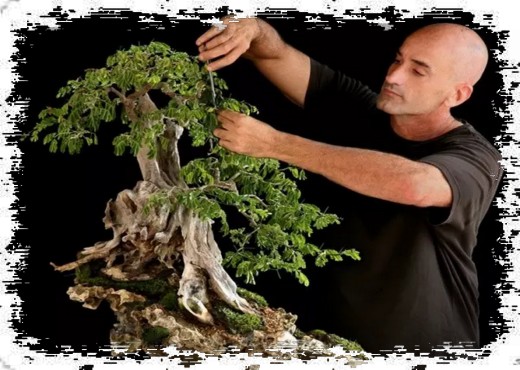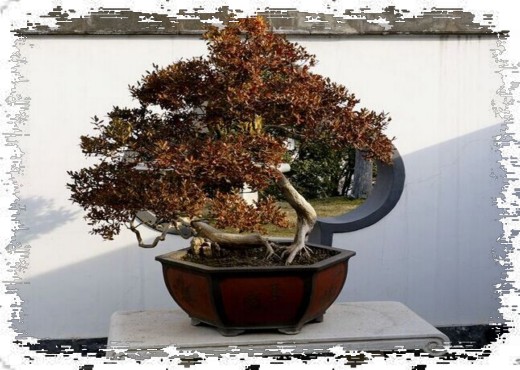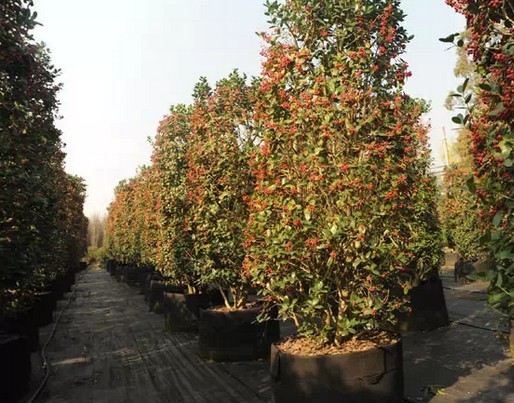How to create bonsai with far-reaching artistic conception
Bonsai, like poetry, painting and garden art, all originate from nature and life, but they have different forms of expression. They permeate each other and learn from each other. Poems and paintings are often drawn from gardens and bonsai, and the creation of gardens and bonsai emphasizes poetic and picturesque. Therefore, the idea and layout of bonsai are all influenced and inspired by poetry and painting, and many excellent bonsai works are created by absorbing the expressive techniques of painting.

However, bonsai is different from poetry, painting and gardens. It is restricted by many objective conditions. Poetry is to express people's feelings in the form of words, describe things, praise the beautiful mountains and rivers of the motherland, it is not restricted by space, painting can use the edges of the picture to outline half of the peaks, to show that the mountains stretch, but the bonsai has no corners to help, can only make a complete mountain peak, so it is limited by space, although the garden is also limited by the actual space, but its available space is much larger than bonsai. Bonsai art takes the basin as paper, draws three-dimensional paintings with plants, mountains and rocks, and uses the expression of bonsai art to concentrate the big dry world in a small basin.
Bonsai art has many schools and styles, and there are some differences in shape and layout. However, "everything remains unchanged". Although they are different in form and style, they all follow some common laws and basic principles. As long as we master these laws and principles, and then combine our own art, we can give full play to them, and we will be handy in the creation of bonsai art.
Bonsai modeling has the following basic principles, which are not only related to each other, but also relatively independent, so only by combining them organically and using them flexibly in creative practice can we obtain the ideal modeling and make the bonsai creation successful.
whatever one wishes to say , his pen follows. The idea is to conceive. Before writing an article, decide what to write and how to write it. The idea of bonsai creation, that is, the theme of bonsai, is to show what and how to express it? The success of bonsai works is directly related to the pros and cons of its intention. Vulgar intention, of course, can not create a novel shape, poetic bonsai. Fang Xun, a poet and painter in the Qianlong period of the Qing Dynasty, said in the Theory of painting on the quiet residence of the Mountain: "painting must first set a mind to determine the position, the meaning is high, the meaning is high, the meaning is far, the meaning is deep, the meaning is left, the meaning is mediocre, and the meaning is vulgar." This is very reasonable.
Some people confuse the idea of bonsai with the artistic conception. In fact, these are two different concepts. Generally speaking, intention is the theme of bonsai, while the artistic conception of bonsai refers to the blending of bonsai works of art and a kind of artistic realm produced by communicating with the emotion and knowledge of the appreciator. It is not the specific shape of bonsai. The artistic conception of bonsai is like the ideological nature of literary works, but it is not as obvious as the ideological nature of literary works. It is inherent and implicit, and requires appreciators to think and associate with their own knowledge in order to appreciate the beauty of it.
For example, when people see that a five-needle pine bonsai with thick and short trunks and luxuriant branches and leaves is named "aspiration is not old", it will make people think of how many young people have made great achievements for the country and nation in the long river of the development of human history, thus stimulating people's lofty aspirations to devote themselves to the motherland and rejuvenate the Chinese nation. This kind of association and imagination is the artistic conception.
There are generally two situations in the idea of bonsai. One is that the author's emotion is stimulated by the outside world, or inspired by something, resulting in the motivation of creation.
For example, when you visit Huangshan Mountain, you see a variety of well-known pine trees at home and abroad, such as welcome pine, inverted pine, and so on, whose tenacious vitality makes people deeply moved, so they want to reproduce the wonderful natural landscape in the form of bonsai. This produces the desire to create, and according to this desire for ideas, and then select materials for creation. Another situation is "falling in love with trees", or "seeing things business". For example, when you dig a good tree stump, or when relatives and friends give you a tree material, the experience of bonsai creation makes you not cut hastily, but look around, look up and down, and ponder over and over again. when the trees in front of you are combined with the images stored in the mind, that is, the shapes of the trees, the idea is completed and the idea is created. The former can be described as "selecting materials according to their intentions", while the latter is "based on their talents". Most of the regular modeling is "material selection", while the natural modeling is mostly "material-based".
First, when you visit famous mountains and rivers, places of interest and historic sites in China, you are deeply affected by the magnificent scenery of the beautiful mountains and rivers of the motherland, and you have a desire to reproduce the natural scenery you have seen. Or inspired by seeing something impressive, you want to create, and then choose appropriate materials to make bonsai to express your feelings.
Bonsai can beautify the environment and give people beautiful enjoyment. So what on earth is beauty? Generally speaking, what is truly beautiful should be consistent with nature on the one hand and ideals on the other, both of which are indispensable. Bonsai has become a wonderful work of art because it can combine natural beauty with artistic beauty. Therefore, in order to understand the beauty of natural flowers and trees and landscapes, we should first learn from nature.
Famous poets and painters, there are many factors for their career success, but they have a common characteristic, that is, they go deep into reality, experience life, and master a large number of first-hand materials.
From conception to creation, a bonsai work is not created behind closed doors out of imagination, but a comprehensive product of the author's life practice, artistic accomplishment, literary level and production skills. Therefore, bonsai creators are required to "travel thousands of miles" to observe, experience, understand nature and discover the beauty that exists in nature. As Comrade Mao Zedong pointed out in his speech at the Yan'an Symposium on Literature and Art: "there are mineral deposits of literary and artistic raw materials in people's life." They are the only inexhaustible source of all literature and art. "
Bonsai creators should also absorb nutrition from painting, literature, sculpture, horticulture and poetry, and learn from the strengths of other bonsai works. As a bonsai creator, we should not only have rich life practice, but also have a wide range of theoretical knowledge. It is necessary to accumulate a wide range of thin hair, grow into bamboo in the heart, and "store" a large number of tree forms in the mind, with thousands of miles of rivers and mountains, famous mountains and rivers, places of interest, and magnificent scenes of nature, and then carry on the idea, conception, composition and creation. As long as you can do this, bonsai works with novel ideas and both spirit and shape will stand out from your hands.
In the process of bonsai creation, we should pay attention to carry forward the strengths of bonsai materials and avoid their weaknesses. Generally speaking, the tree material used to make bonsai is luxuriant. After seeing the material, experienced bonsai creators generally do not start pruning immediately, but first find out the strengths of the material and conceive it, when a suitable bonsai design is considered to be mature, and then start sawing, trimming and pruning. Make full use of the original beautiful natural shape of the bonsai material, and remove the defective or superfluous parts at the same time; if it cannot be removed, take the beautiful and attractive parts as the viewing surface, and put the defective or unbeautiful parts on the back. Bonsai materials for such a concept, modeling, can achieve the purpose of giving full play to their strengths and avoiding weaknesses.
When the bonsai is stereotyped and pruned, some cut off most of the branches, leaving only a short section of the trunk and 3 or 5 branches, which is the specific application of "simplicity in complexity" in the modeling of bonsai trees.
In the complex, the simplicity mentioned by Jane is not an end, but a means. This is not to simplify, nor is it to be as simple as possible, but to win more with less and more with simplicity over complexity. For example, the Jane with the proper peak in the landscape bonsai can highlight the main peak. When making bonsai, we should grasp it flexibly according to the specific situation, when it is simple, it is simple, when it is complex, it is complicated.
Everything in the universe does not exist in isolation, but is interrelated. The size of large and small can be revealed only by comparing the two relatively, that is, without big, there can be no small, and without small, there can be no big. Through a small part to see the whole, small is the means, not the end; small is the form, large is the content, through the small object to show the tallness of the subject. Not only bonsai, painting, photography, sculpture and other arts, but also through a small part of the artistic techniques to see the whole to create. The ancients said, "write the scenery of thousands of miles with a picture close at hand", which means to express the grandeur of nature with small pictures, and to achieve the effect of "thousands of miles" in artistic creation. In the bonsai of trees, you can often see the shape of one tall and one short, one big and one small, always oblique. Generally speaking, tall, large and straight trees are the main body, while short, small and oblique trees are the object. the two are not only different in posture, but also varied in temperament and shape, and its purpose is to "serve against the master". The object is the foil, in order to highlight the subject, we should pay attention to "the guest does not deceive the subject" and "the guest follows the subject".
The small in bonsai art is not really small, but "to see the whole through a small part". The so-called big is not simply big, but larger than small. A few small trees, scattered and orderly planted in a rectangular pot, looked like a forest in front of us from afar. This is the charm of bonsai art to "see the whole through a small part".
Time: 2019-05-23 Click:
- Prev

The artistic style characteristics of Jinling Bonsai
Bonsai is a traditional art in China with a long history. It originated in Tang Dynasty, developed in Song Dynasty and flourished in Ming and Qing dynasties. Among them, Jinling bonsai has a rich artistic style and distinctive features, which depends on the production materials and skills. First, Jinling bonsai materials, focusing on local endemic or suitable for local growth of plants and local mountains and rocks
- Next

Christmas holly-bonsai without thorns
At Christmas, many people choose a pine tree as a Christmas tree and plant it at home, decorated with ribbons, balloons and gifts. In fact, pine is not the best choice, thornless wolfberry bone is a commonly used Christmas tree variety in Europe and the United States, because it is a mixture of Christmas red and holly green. It doesn't have the national beauty of peony.
Related
- Fuxing push coffee new agricultural production and marketing class: lack of small-scale processing plants
- Jujube rice field leisure farm deep ploughing Yilan for five years to create a space for organic food and play
- Nongyu Farm-A trial of organic papaya for brave women with advanced technology
- Four points for attention in the prevention and control of diseases and insect pests of edible fungi
- How to add nutrient solution to Edible Fungi
- Is there any good way to control edible fungus mites?
- Open Inoculation Technology of Edible Fungi
- Is there any clever way to use fertilizer for edible fungus in winter?
- What agents are used to kill the pathogens of edible fungi in the mushroom shed?
- Rapid drying of Edible Fungi

